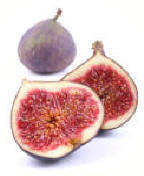|
Your online resource for all things culinary |
|
|||||||||
|
||||||||||
|
||||||||||
| Â | ||||||||||
|
||||||||||
|
The fruits are either hand picked from the tree or gathered by mechanical sweepers after they have ripened and fallen to the ground. When hand picking, the wearing of gloves is advisable as certain cells in the plant produce a latex that contains ficin, a protein-decomposing enzyme which is an irritant to the skin and can cause dermatitis. Â When dried, figs become more flattened. They lose their pear-like shape and become rounded. Depending on their quality, they are either naturally dried or process dried. Natural-dried figs are threaded onto cords or into rings and dried in the sun or by machine. During the drying the fruit exudes a glucose which crystallizes on the surface giving it a dull appearance. Process-dried figs undergo several procedures, namely drying, immersion in salt water, pressing and then drying again. The pressing gives the figs a shiny appearance. Â Â Buying and Storing FigsÂ
Fresh
figs must be fully ripened on the tree to be of the best quality and flavour.
Ripeness or maturity cannot be judged by the colour as this differs, depending
on the variety, from very deep purple to yellow. A ripe fig is soft and yielding
to the touch, but not mushy. Choose fruit whose skins and just about to break
but careful not to bruise the fruit, as this will make it spoil very quickly.
They should be clean, dry and smooth skinned. Take a sniff -Â a sour odour
indicates that it has already started to decompose and ferment. A very firm fig
is not ripe and as mentioned above, will not properly ripen any further. It's important to keep fresh figs cool to retard deterioration. Use them immediately or store in a plastic bag in the coldest part of your refrigerator for up to two days. Figs can be frozen whole, sliced or peeled in a sealed container for ten to twelve months. They can also be purchased in tins. Dried figs have a shelf life of over a year if stored in cool low humidity conditions. Cooking with FigsÂ
The
flavour of figs go particularly well with Prosciutto, Parma ham, and cheese and
because they produce protein-digesting enzymes which break down muscle and
connective tissue in meat, they make an excellent ingredient in meat dishes
acting as a tenderiser as well as a flavour-enhancer. Dried figs can be used
interchangeably with prunes, dried apricots, and dates in most recipes.
Equivalents  Click here for lots of recipes using fresh and dried Figs |
||||||||||
Â
|
||||||||||
| Â | ||||||||||

 Figs are
members of the genus Ficus belonging to the family Moraceae (mulberry family)
and are one of the earliest fruits cultivated by man. The fig tree was mentioned
very early on in The Bible and some scholars believe the forbidden fruit picked
by Eve was a fig rather than an apple, which would actually make more sense as
it�s supposed to be a fig leaf which Adam chose to �protect his modesty�.
Figs are
members of the genus Ficus belonging to the family Moraceae (mulberry family)
and are one of the earliest fruits cultivated by man. The fig tree was mentioned
very early on in The Bible and some scholars believe the forbidden fruit picked
by Eve was a fig rather than an apple, which would actually make more sense as
it�s supposed to be a fig leaf which Adam chose to �protect his modesty�.  Fig
trees can grow over 50 feet tall in the wild however, commercially grown trees
are usually kept to below 15 feet and look more like a large shrub or bush.
Newly planted seedlings start bearing fruit after 5-7 years and continue to
produce fruit for a very long time. Trees which were planted at the beginning of
commercial fig production in America about 100 years ago are still bearing fruit
today.
Fig
trees can grow over 50 feet tall in the wild however, commercially grown trees
are usually kept to below 15 feet and look more like a large shrub or bush.
Newly planted seedlings start bearing fruit after 5-7 years and continue to
produce fruit for a very long time. Trees which were planted at the beginning of
commercial fig production in America about 100 years ago are still bearing fruit
today.